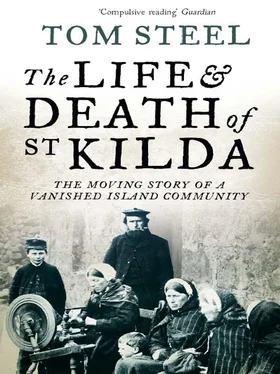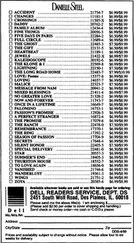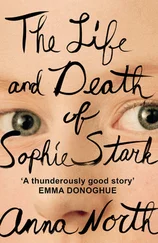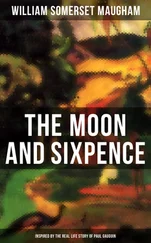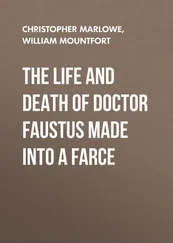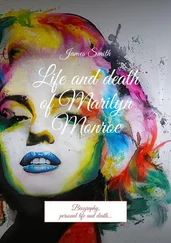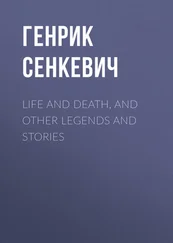The mailbags taken aboard the Dunara Castle that day were not the only mail sent from St Kilda. Three days earlier. Alasdair Alpin MacGregor and Neil Ferguson had despatched the last traditional St Kildan mailboat. Within its wooden hold was placed a solitary postcard addressed to the island’s owner at Dunvegan, in the Isle of Skye. The wooden vessel, attached to an inflated stomach of a sheep, had been cast into the sea. ‘This’, read the postcard, ‘is the last mail from St Kilda.’
Meanwhile, the Master of Reay was being persuaded at great length by Alasdair Alpin MacGregor not to try to remain on the island. The Master, heir to the Chief of Clan Mackay, had come ashore from the Dunara Castle with the intention of remaining on St Kilda for a few weeks to do some exploring. He had even gone as far as to bring a load of provisions with him to last him throughout his period of isolation. The Dunara Castle’s sister ship Hebrides, he thought, was to make yet another trip that summer and he was relying on that to take him off before the winter. But Dr Shearer, sent by the Department of Health to carry out the evacuation, put an end to the young Robinson Crusoe’s plans by saying no.
The Scottish Office and the proprietor of the island had already turned down hundreds of requests from people wanting to live on St Kilda. The government received more than four hundred enquiries and pleadings from those eager to accept that which the St Kildans were abandoning.
Sir Reginald MacLeod of MacLeod, the proprietor of the island, had told the Glasgow Herald in an interview, ‘I am sorry to lose a population that has down its generations been tenants of my family for a thousand years. But they themselves have elected to go, and I cannot blame them. The life is one of hardship and inconvenience.’ Sir Reginald played a minor role in the decisions that had to be made at the evacuation but was determined, as was the government, that no one should live on St Kilda after 29 August 1930. ‘At all events,’ he told the Herald’s correspondent, ‘I am strongly opposed to the idea of new settlers. The present population have signed and sent a petition for removal which, at great trouble and expense, is now being carried out. In these circumstances it would be folly to remove one lot of people who know the island, and replace them with a group of strangers.’
The last thirty-six St Kildans on the island were sad but not sorry they were leaving. They had been convinced by the nurse and the missionary that they were leaving for a better land. The experience of living on St Kilda in the last few years had shown them they could not be leaving for a more inhospitable world.
The Dunara Castle had brought not only tourists and journalists, but also various officials who had work to do on St Kilda. The Examiner of Registration Records came ashore to check the island’s entries of births, deaths and marriages with the missionary, Dugald Munro, who had been responsible for keeping them. Nurse Williamina Barclay told the Examiner that she had not had to assist with the birth of a single child since she came to St Kilda over two years before. No one had been born on St Kilda since 1927, when the youngest of the Mackinnons, Neil, was born. The books duly checked and signed by the Examiner were transferred to the vaults of Register House in Edinburgh. No further entries would be made.
At noon the Dunara Castle sailed for Oban. The journey would take seventeen hours and the skipper was anxious to be safely through the dangerous Sound of Harris in daylight. Together with the beasts and belongings went the last outsiders – the journalists, photographers, and visitors. No one but a few government officials was to be allowed to remain on the island until the end. Alasdair Alpin MacGregor had gone as far as to petition the Prime Minister to allow him to stay and witness the evacuation, but the reply from the Scottish Office had been definite: ‘The Admiralty are naturally hostile to the idea of publicity and Mr Johnston himself is strongly of the opinion that the utmost effort should be made to avoid the miseries of the poor people being turned into a show…The Scottish Office are endeavouring to carry out the evacuation with as little publicity as possible out of consideration for the feelings of the St Kildans themselves.’ Tom Johnston, then Under-Secretary of State for Scotland, had decided there would be no cinema newsreel cameras present, no press photographers to capture for publication the first tears of sadness, no witness of any description to the emotions that were felt by the St Kildans between noon on 28 August and eight o’clock on the morning of the 29th. The officials even rejected a request from a former islander, Donald MacQueen, who wished to see for himself the removal, as he put it, ‘of the last remnants of my race’. He had asked if the Department could help him get to St Kilda because, he wrote, ‘owing to having to exist on seventeen shillings a week, I could not manage home to my people’.
One of the first tasks that had to be carried out once the sheep had been taken off was to deal with the island’s numerous dogs. They were no longer of use to the St Kildans, and despite the pleadings of the National Canine Defence League and numerous offers from people on the mainland to adopt them, the dogs were put to death. Dr Shearer, assisted by Commander Pomfret of the Harebell, was able to destroy only two dogs with hydrocyanic acid in a room in one of the empty houses. The St Kildans stubbornly demanded that they drown the rest. A stone was tied round the neck of each dog and they were thrown off the end of the jetty. Weeks later, when the Hebrides paid a visit to the island, the bay was still full of dead dogs.
It seemed to the St Kildans that everyone had been interested in their island during the past few weeks. But it was their home and they would not be badgered, bribed, or bullied into doing things they did not want to do. Offers of help were made, but few were taken up. The afternoon of the 28th was spent ferrying out the islanders’ belongings to the Harebell, and the work went on well into the night. As the women carried the last few bundles down to the pier, the men of the British Navy looked on. They were prepared to help, but the St Kildans did not want to be assisted in these last hours by representatives of a society that had ignored them for centuries. The sailors could only stand and watch, and the islanders were heard to murmur to one another that they would not be rushed should the entire Navy come out for them.
By seven o’clock next morning, there was little left for the St Kildans to do save board the Harebell. The islanders put on their best clothes. If they did not feel a desire to impress their new neighbours on the mainland upon arrival, they were certainly determined that they would not be the subject of ridicule. The family prayers were said for the last time and, as was the custom among Gaelic people, a Bible was left open in each house, along with a small heap of oats. In one house the exposed text was Exodus.
In each of the eleven inhabited cottages, the fire was built up with fresh coal and turf. When they were burnt out some hours later, it was probably the first time there had not been a fire on St Kilda for a thousand years. Lachlan Macdonald, then a young man just turned twenty-four, recalls: ‘I mind of everyone closing the door of his house and some of them read a chapter of the Bible before they left, and put up a prayer.’
Neil Ferguson, son of the postmaster, and the last male islander to marry and set up a home of his own on St Kilda, remembers those last hours well. ‘You had a bed and chairs and them old-fashioned chests and all that stuff. All that stuff was left on the island when we left. Most of the furniture was left in the houses – dressers, and even pots and pans and stuff like that – all left. And all them pots they used to have in the old days with three legs, they were all left. And all the fishing gear was left, lines and boats. Oh, we never took much away, we were just running away and leaving everything.’
Читать дальше
